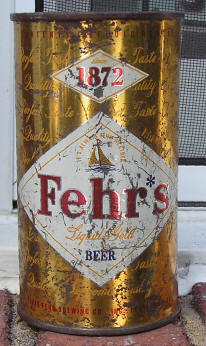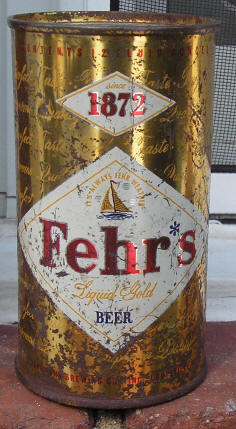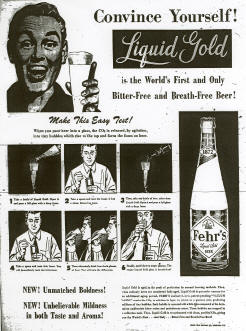Fehrs Liquid Gold, 1954
 |
 |
 |
In the Spring of 1954 Frank Fehr Brewing Company introduced a new product called “Liquid Gold.” They used full page black and gold advertisements promoting Liquid Gold as “…the world’s first and only bitter-free and breath-free beer.” “Breath-free” referred to the lack of a beery smell left behind. They bragged about the brewing process used to make Liquid Gold, called "Vacuum Aging.” Fehrs ads described vacuum aging as “solving one of the oldest problems of the brewing industry: how to remove bitterness and malodor from beer.” “Bitterness” they claimed, “is due to harsh tasting resins derived from the boiling of hops. The malodor is caused by fermentation with yeast. Filtering cannot remove these objectionable qualities in beer because they are in liquid form…'Vacuum aging’ can and does remove them.”
The ads suggested that consumers conduct a test.
First, take a bottle of Liquid Gold. Open it and pour a full glass with a deep foam. Second, take a spoon and taste the foam. It has a clean, bitter-free taste. Third, take any bottle of beer, other than Liquid Gold. Open it and pour a full glass with a deep foam. Fourth, take a spoon and taste this foam. You will immediately taste the bitterness. Fifth, alternatively drink from both glasses of beer. You will taste the difference. Last, smell the two empty glasses. The empty Liquid Gold glass is breath-free.” Fehr's Full Page ad with the "Liquid Gold" text. (Click to see full size)
What the heck was “vacuum aging?” They described the process. Once the beer was aged, it was placed under a vacuum. This caused the CO2 to change to a gaseous state which produced “millions of bubbles.” Each bubble “was covered with a thin film composed of the unfilterable bitter resins and the malodorous esters.” A brewer friend of mine noted that this would remove the carbonation (making the beer flat unless it was re-added) and would make the beer bland by removing some of the taste. As he wrote me, "I'm guessing it meant they were trying to make their beer as flavorless as possible...."
Liquid Gold also had a unique sales gimmick. A small vial of the filtrate called gurk given to the customers to show what had been filtered out of the beer. (According to the same brewer friend, "gurk" may come from kieselguhr, the German word for fossil earth/diatomaceous earth which is used to filter beer. Coarser grades used for swimming pool filters. Also a good slug-killer, as the teeny sharp edges lacerate them to bleeding stubs!)
The brand initially sold well, especially when it gained a reputation for not being detectable on the consumer's breath as noted by the beer's slogan, "it's breathless!" According to one old brewery employee they once ran out of beer bottles and used catsup bottles to ship it to Fort Knox. The gimmick was ultimately not a success, however, especially since it implied that all other beers were insufficiently filtered, and therefore unhealthy, including Fehr's XL. Customers wondered why Fehr's would sell their other brands with the "gurk" still in it. Oops. It did leave collectors with a semi-tough flat top can to look for, but it was not a success for the brewery.
The End
As sales dropped Fehr's began a merry-go-round series of management changes as Frank Fehr III and his nephew Fehr Kremer battled for control of the company, switching places as the brewery's President. In 1957 Fehr's was again losing money and, hit by a lien for back taxes by the IRS, filed for Chapter X bankruptcy. It was reorganized in March 1959 with entirely new leadership. Liquid Gold had been dropped and the brewery was selling Fehr's Pasteurized Draught Beer, Fehr's XL, and Kentucky Malt Liquor/Lager. However, even though sales increased the brewery continued losing money. In 1964 it was closed and in 1968 the corporation was sold with Schoenling in Cincinnati buying the brand names and beer formulas. The last 7,000 barrels of beer were dumped into the sewers. The brewery site current tenant is a senior citizens housing development.
Frank Fehr Brewing: Name Changes and Predecessors
Otto Brewery (Frank Fehr) (430 East Green Street) 1872-1876
Frank Fehr (Old Brewery) 1876-1890
Frank Fehr Brewing Company 1890-1901
Frank Fehr Brewing Company (new location at 412/425 Fehr Ave) 1901-1918
Frank Fehr Brewing Company 1933-1964
Sources Used:
Guetig, Peter R. and Conrad D. Selle. Louisville Breweries: A History of the Brewing Industry in Louisville, Kentucky New Albany and Jeffersonville, Indiana. (Mark Skaggs Press, 1995) 84-104.
Van Wieren, Dale P. American Breweries II (West Point, PA.: East Coast Breweriana Association, 1995) 123.
Thanks Matt!

